microsoft az-120 practice test
Planning and Administering Microsoft Azure for SAP Workloads
Note: Test Case questions are at the end of the exam
Last exam update: Jul 20 ,2024
Question 1 Topic 5, Mixed Questions
DRAG DROP
You have an SAP environment on Azure.
You use Azure Recovery Services to back up an SAP application server.
You need to test the restoration process of a file on the server.
Which three actions should you perform in sequence? To answer, move the appropriate actions from the list of actions to the
answer area and arrange them in the correct order.
Select and Place: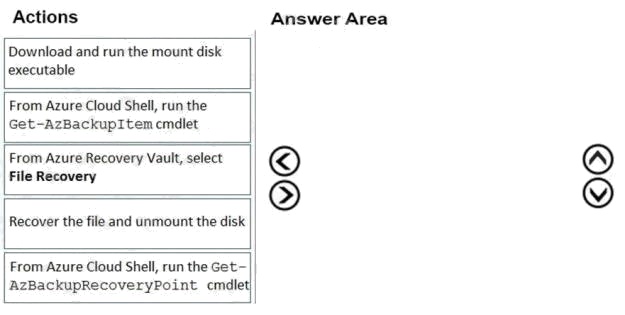
Answer:
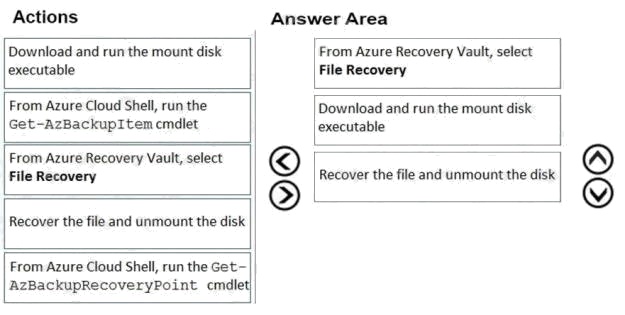
Explanation:
Step 1: From Azure Recover Vault, select File Recovery
To restore files or folders from the recovery point, go to the virtual machine and choose the desired recovery point.
Step 2: Download and run the mount disk executable
Step 3: recover the file and unmount the disk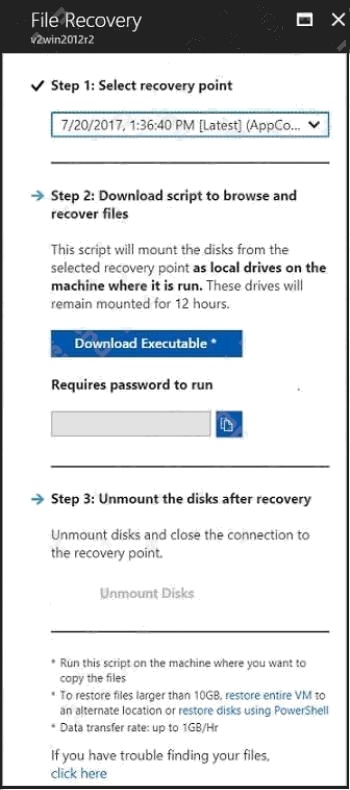
Question 2 Topic 5, Mixed Questions
HOTSPOT
You have an on-premises SAP environment. Application servers run on SUSE Linux Enterprise Server (SLES) servers.
Databases run on SLES servers that have Oracle installed.
You need to recommend a solution to migrate the environment to Azure. The solution must use currently deployed
technologies whenever possible and support high availability.
What should you include in the recommendation? To answer, select the appropriate options in the answer area.
NOTE: Each correct selection is worth one point.
Hot Area: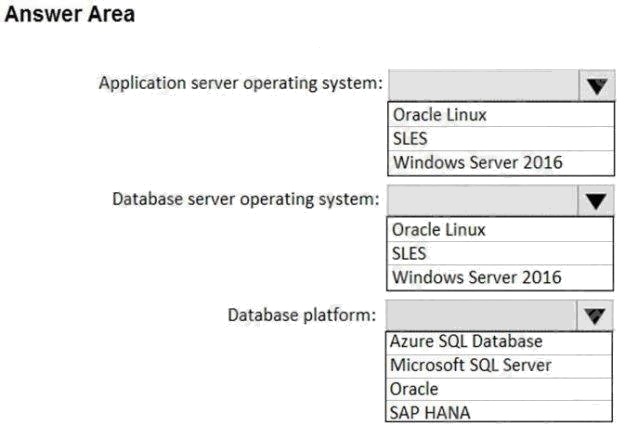
Answer:
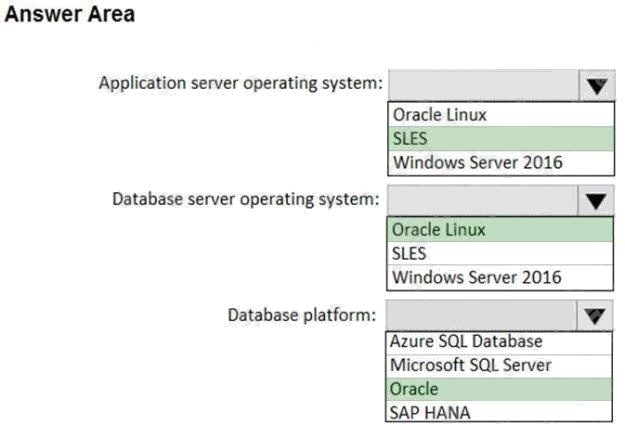
Question 3 Topic 5, Mixed Questions
You have an on-premises SAP environment hosted on VMware vSphere.
You plan to migrate the environment to Azure by using Azure Site Recovery.
You need to prepare the environment to support Azure Site Recovery.
What should you deploy first?
- A. an on-premises data gateway to vSphere
- B. Microsoft System Center Virtual Machine Manager (VMM)
- C. an Azure Backup server
- D. a configuration server to vSphere
Answer:
D
Explanation:
When you set up disaster recovery for on-premises VMware VMs, Site Recovery needs access to the vCenter
Server/vSphere host so that the Site Recovery process server can automatically discover VMs, and fail them over as
needed. By default the process server runs on the Site Recovery configuration server. Add an account for the configuration
server to connect to the vCenter Server/vSphere host.
Reference: https://docs.microsoft.com/en-us/azure/site-recovery/vmware-azure-manage-vcenter
Question 4 Topic 5, Mixed Questions
You need direct connectivity from an on-premises network to SAP HANA (Large Instances). The solution must meet the
following requirements:
Minimize administrative effort.
Provide the highest level of resiliency.
What should you use?
- A. ExpressRoute Global Reach
- B. Linux IPTables
- C. ExpressRoute
- D. NGINX as a reverse proxy
Answer:
C
Explanation:
The Azure network functionality used is:
Azure virtual networks are connected to the ExpressRoute circuit that connects to your on-premises network assets.
An ExpressRoute circuit that connects on-premises to Azure should have a minimum bandwidth of 1 Gbps or higher. This
minimal bandwidth allows adequate bandwidth for the transfer of data between on-premises systems and systems that run
on VMs. It also allows adequate bandwidth for connection to Azure systems from on-premises users.
All SAP systems in Azure are set up in virtual networks to communicate with each other.
Reference: https://docs.microsoft.com/en-us/azure/virtual-machines/workloads/sap/hana-network-architecture
Question 5 Topic 5, Mixed Questions
HOTSPOT
You have an on-premises SAP environment.
Backups are performed by using tape backups. There are 50 TB of backups.
A Windows file server has BMP images of checks used by SAP Finance. There are 9 TB of images.
You need to recommend a method to migrate the images and the tape backups to Azure. The solution must maintain
continuous replication of the images.
What should you include in the recommendation? To answer, select the appropriate options in the answer area.
NOTE: Each correct selection is worth one point.
Hot Area: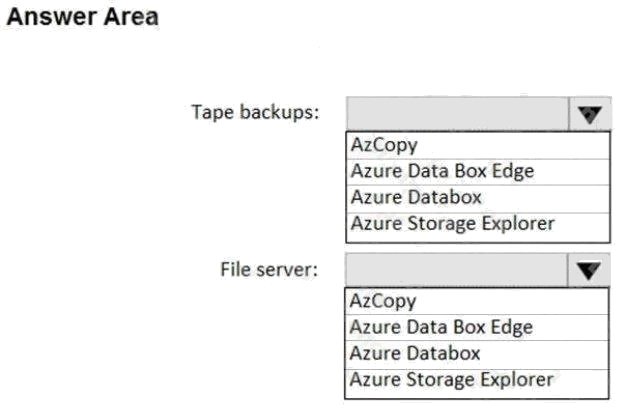
Answer:
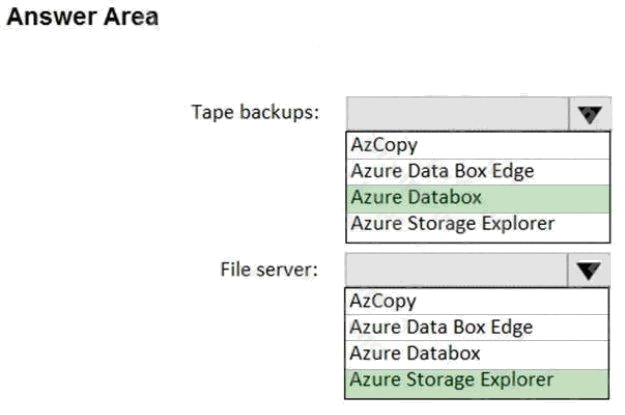
Explanation:
Tape backups: Azure DataBox
The Microsoft Azure Data Box cloud solution lets you send terabytes of data into Azure in a quick, inexpensive, and reliable
way. The secure data transfer is accelerated by shipping you a proprietary Data Box storage device. Each storage device
has a maximum usable storage capacity of 80 TB and is transported to your datacenter through a regional carrier. The
device has a rugged casing to protect and secure data during the transit.
File server: Azure Storage Explorer
Azure Storage Explorer is an application which helps you to easily access the Azure storage account through any device on
any platform, be it Windows, MacOS, or Linux. You can easily connect to your subscription and manipulate your tables,
blobs, queues, and files.
Incorrect Answers:
Not Azure Data Box Edge: Azure Data Box Edge is rebranded as Azure Stack Edge. Azure Stack Edge is a Hardware-as-a-
service solution. Microsoft ships you a cloud-managed device with a built-in Field Programmable Gate Array (FPGA) that
enables accelerated AI-inferencing and has all the capabilities of a network storage gateway.
Reference:
https://docs.microsoft.com/en-us/azure/databox/data-box-overview https://github.com/MicrosoftDocs/azure-
docs/blob/master/articles/vs-azure-tools-storage-manage-with-storage-explorer.md
Question 6 Topic 5, Mixed Questions
You deploy an SAP production landscape on Azure virtual machines that run SUSE Linux Enterprise Server (SLES).
You need to generate a report that details performance differences between instances of an SAP AS ABAP system.
What should you use?
- A. JMeter
- B. ABAPmeter
- C. Micro Focus LoadRunner
- D. SAP UI Speedtest Tool
Answer:
B
Explanation:
Use ABAPMETER in NetWeaver AS ABAP when you want to test the general performance/health of each instance in a
NetWeaver AS ABAP system.
Incorrect Answers:
D: The SAP UI Speedtest Tool is used to network bandwidth and latency.
The UI5 Speedtest Tool regularly checks your network connection and allows you to review the results via a UI5 web
interface.
Reference: https://userapps.support.sap.com/sap/support/knowledge/en/2879613
Question 7 Topic 5, Mixed Questions
HOTSPOT
You have an on-premises SAP landscape and an Azure subscription that contains a virtual network named VNET1. VNET1
has the following settings.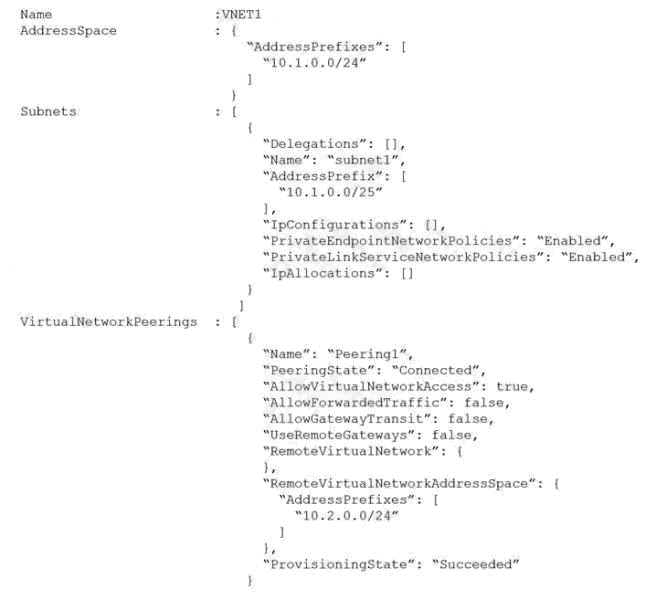
You plan to migrate the landscape to Azure.
You need to configure VNET1 to support the SAP landscape.
Use the drop-down menus to select the answer choice that completes each statement based on the information presented in
the settings.
NOTE: Each correct selection is worth one point.
Hot Area: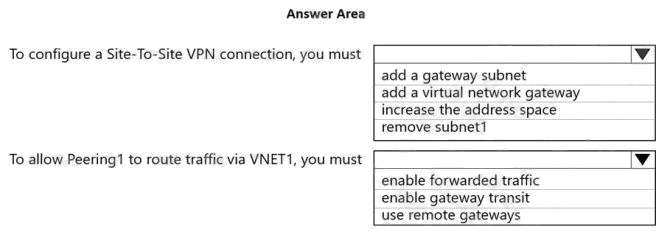
Answer:
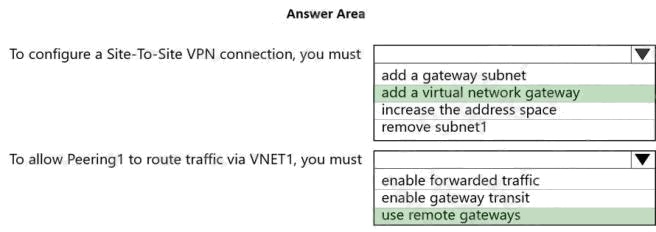
Explanation:
Box 1: add a virtual network gateway
Box 2: use remote gateways
Each virtual network, regardless of whether peered with another virtual network, can still have its own gateway to connect to
an on-premises network. When you peer virtual networks, you can also configure the gateway in the peered virtual network
as a transit point to an on-premises network. In this case, the virtual network that uses a remote gateway cannot have its
own gateway. A virtual network can have only one gateway that can be either a local or remote gateway (in the peered
virtual network).
Reference: https://docs.microsoft.com/en-us/azure/virtual-network/virtual-network-peering-overview
Question 8 Topic 5, Mixed Questions
You plan to deploy an SAP landscape that will have virtual machines deployed to multiple Azure regions.
You need to ensure that the virtual machines can communicate across the regions.
What should you configure?
- A. virtual network peering in Azure
- B. Azure Bastion hosts
- C. local network gateways
- D. Azure Relay
Answer:
A
Explanation:
Depending on the rules and restrictions you want to apply between the different virtual networks hosting VMs of different
SAP systems, you should peer those virtual network
Note: Virtual network peering enables you to seamlessly connect two or more Virtual Networks in Azure. The virtual
networks appear as one for connectivity purposes. The traffic between virtual machines in peered virtual networks uses the
Microsoft backbone infrastructure. Like traffic between virtual machines in the same network, traffic is routed through
Microsoft's private network only.
Azure supports the following types of peering:
Virtual network peering: Connect virtual networks within the same Azure region.
Global virtual network peering: Connecting virtual networks across Azure regions.
Incorrect Answers:
B: Azure Bastion is a fully managed service that provides more secure and seamless Remote Desktop Protocol (RDP) and
Secure Shell Protocol (SSH) access to virtual machines (VMs) without any exposure through public IP addresses.
D: The Azure Relay service enables you to securely expose services that run in your corporate network to the public cloud.
You can do so without opening a port on your firewall, or making intrusive changes to your corporate network infrastructure.
Reference:
https://docs.microsoft.com/en-us/azure/virtual-machines/workloads/sap/hana-network-architecture
https://docs.microsoft.com/en-us/azure/virtual-network/virtual-network-peering-overview
Question 9 Topic 5, Mixed Questions
HOTSPOT
You deploy an Azure Internal load balancer.
You deploy a node of an SAP NetWeaver 7.4 ABAP system named SP1.
You plan to deploy a second node.
You need to verify that the health probe port is configured for the cluster. The cluster IP address resource name is SAP SP1
IP.
How should you complete the command? To answer, select the appropriate options in the answer area.
NOTE: Each correct selection is worth one point.
Hot Area: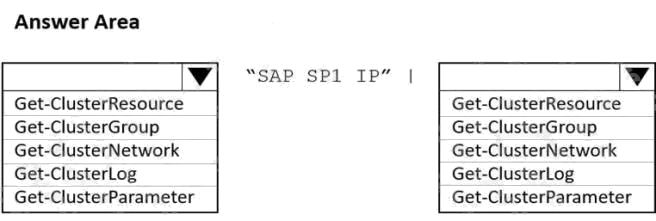
Answer:
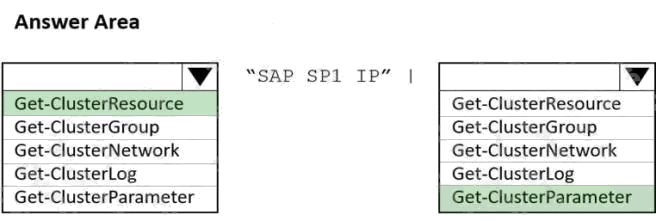
Explanation:
Box 1: Get-ClusterResource Example:
Get-ClusterResource -Name $SAPIPresourceName | Get-ClusterParameter
Write-Output " "
Write-Output "Current probe port property of the SAP cluster resource '$SAPIPresourceName' is '$OldProbePort'."
Write-Output " "
Write-Output "Setting the new probe port property of the SAP cluster resource '$SAPIPresourceName' to '$ProbePort' ..."
Write-Output " " Box 2: Get-ClusterParameter
Reference: https://docs.microsoft.com/en-us/azure/virtual-machines/workloads/sap/sap-high-availability-installation-wsfc-
shared-disk
Question 10 Topic 5, Mixed Questions
You have an SAP landscape on Azure.
You deploy an SAP Web Dispatcher named web1.
You need to confirm that web1 can support 1,500 users.
What should you use?
- A. Apache JMeter
- B. lometer
- C. ABAPMeter
- D. FIO
Answer:
A
Question 11 Topic 5, Mixed Questions
You recently migrated an SAP HANA environment to Azure.
You plan to back up SAP HANA databases to disk on the virtual machines, and then move the backup files to Azure Blob
storage for retention.
Which command should you run to move the backups to the Blob storage?
- A. robocopy
- B. backint
- C. azcopy
- D. scp
Answer:
C
Explanation:
To store directories and files on Azure storage, one could use CLI or PowerShell. There is also a ready-to-use utility,
AzCopy, for copying data to Azure storage.
Reference: https://docs.microsoft.com/en-us/azure/virtual-machines/workloads/sap/sap-hana-backup-file-level
Question 12 Topic 5, Mixed Questions
DRAG DROP
You have an SAP environment on Azure.
You use Azure Site Recovery to protect an SAP production landscape.
You need to validate whether you can recover the landscape in the event of a failure. The solution must minimize the impact
on the landscape.
Which four actions should you perform in sequence? To answer, move the appropriate actions from the list of actions to the
answer area and arrange them in the correct order.
Select and Place: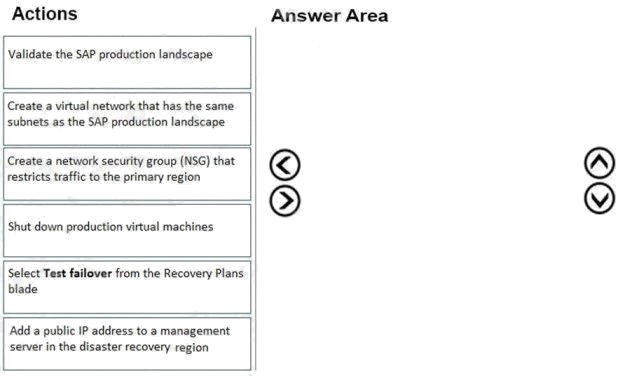
Answer:
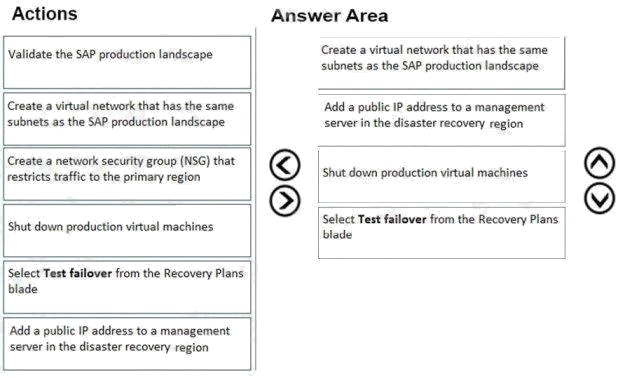
Explanation:
Step 1: Create a virtual network...
We recommended that for test failover, you choose a network that's isolated from the production recovery site network
specific in the Compute and Network settings for each VM. By default, when you create an Azure virtual network, it is
isolated from other networks. The test network should mimic your production network:
The test network should have same number of subnets as your production network. Subnets should have the same names.
The test network should use the same IP address range.
Step 2: Add a public IP address...
Because Site Recovery does not replicate the cloud witness, we recommend that you deploy the cloud witness in the
disaster recovery region.
Step 3: Shut down production virtual machines
Make sure that the primary VM is shut down when you run the test failover. Otherwise there will be two VMs with the same
identity, running in the same network at the same time. This can lead to unexpected consequences.
Step 4: Select Test failover from the Recovery Plans blade
Reference:
https://docs.microsoft.com/en-us/azure/site-recovery/site-recovery-test-failover-to-azure
Question 13 Topic 5, Mixed Questions
Note: This question is part of a series of questions that present the same scenario. Each question in the series contains a
unique solution that might meet the stated goals. Some question sets might have more than one correct solution, while
others might not have a correct solution.
After you answer a question in this section, you will NOT be able to return to it. As a result, these questions will not appear in
the review screen.
You deploy SAP HANA on Azure (Large Instances).
You need to back up the SAP HANA database to Azure.
Solution: You use a third-party tool that uses backint to back up the SAP HANA database to Azure storage.
Does this meet the goal?
- A. Yes
- B. No
Answer:
B
Explanation:
Reference: https://docs.microsoft.com/en-us/azure/backup/sap-hana-db-about https://docs.microsoft.com/en-
us/azure/backup/backup-azure-sap-hana-database#configure-backup
Question 14 Topic 5, Mixed Questions
What should you use to perform load testing as part of the migration plan?
- A. JMeter
- B. SAP LoadRunner by Micro Focus
- C. Azure Application Insights
- D. Azure Monitor
Answer:
B
Explanation:
Scenario: Upgrade and migrate SAP ECC to SAP Business Suite on HANA Enhancement Pack 8.
With the SAP LoadRunner application by Micro Focus, you can accelerate testing and development, reduce slowdowns and
expenses, and gain a better understanding of performance issues. Validate software performance, virtualize your network,
simulate workloads, benchmark production system performance, and optimize your deployment of SAP HANA software
References: https://www.sap.com/products/loadrunner.html
Question 15 Topic 5, Mixed Questions
You have an Azure virtual machine that runs SUSE Linux Enterprise Server (SLES). The virtual machine hosts a highly
- A. ethtool
- B. netsh
- C. iometer
- D. fio
Answer:
A
Explanation:
Check for activity on the VF (virtual function) with the ethtool -S eth0 | grep vf_ command. If you receive output similar to the
following sample output, accelerated networking is enabled and working.
vf_rx_packets: 992956 vf_rx_bytes: 2749784180 vf_tx_packets: 2656684 vf_tx_bytes: 1099443970 vf_tx_dropped: 0
Accelerated Networking is now enabled for your VM.
Incorrect Answers:
B: Network shell (netsh) is a command-line utility that allows you to configure and display the status of various network
communications server roles and components after they are installed on computers running Windows Server.
C: Iometer is an I/O subsystem measurement and characterization tool for single and clustered systems. It is used as a
benchmark and troubleshooting tool and is easily configured to replicate the behaviour of many popular applications. One
commonly quoted measurement provided by the tool is IOPS.
D: FIO is a popular tool to benchmark storage on the Linux VMs. It has the flexibility to select different IO sizes, sequential or
random reads and writes. It spawns worker threads or processes to perform the specified I/O operations. You can specify
the type of I/O operations each worker thread must perform using job files
Reference:
https://docs.microsoft.com/en-us/azure/virtual-network/create-vm-accelerated-networking-cli